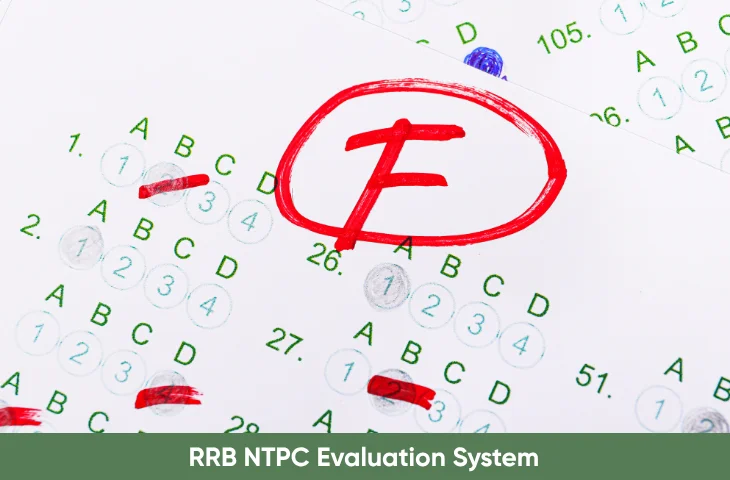The RRB NTPC Evaluation System plays a crucial role in ensuring fairness, transparency, and accuracy in one of India’s largest government recruitment exams. With millions of aspirants appearing for various levels (2, 3, 4, 5, and 6) across multiple phases, the Railway Recruitment Boards (RRBs) use a combination of OMR-based and Computer-Based Tests (CBT). This article explores in detail how the RRB NTPC Evaluation System works – from answer sheet scanning and normalization to result declaration – and why candidates can trust its integrity.
Understanding the RRB NTPC Exam Structure
Before exploring the evaluation process, it’s essential to understand the RRB NTPC Exam Pattern. The stages of RRB NTPC Exam are given below:
- Stage 1: Computer-Based Test (CBT-1) – Preliminary screening
- Stage 2: Computer-Based Test (CBT-2) – Post-wise main examination
- Stage 3: Typing Skill Test / Computer-Based Aptitude Test (for specific posts)
- Stage 4: Document Verification & Medical Examination
Each stage is designed to evaluate the candidate’s aptitude, technical knowledge, and suitability for various non-technical posts in the Indian Railways.
Evolution of the RRB NTPC Evaluation System
Over the years, RRBs have evolved from traditional OMR-based exams to fully computer-based evaluation systems. Let’s look at this transformation:
| Stage | Earlier Process | Current Process |
| Written Exam | OMR sheet-based paper tests | Online Computer-Based Test (CBT) |
| Evaluation | Manual scanning of OMR sheets | Automated computer evaluation |
| Result Compilation | Regional compilation | Centralized digital result generation |
| Normalization | Not applicable | Standardized normalization process across shifts |
How the OMR-Based Evaluation Works?
Though RRB NTPC now primarily uses CBT, some departmental or legacy exams may still involve OMR-based tests. Given below are the steps of evaluation:
Step 1: Secure Collection and Coding
- Each OMR answer sheet is barcoded with a unique roll number.
- The candidate’s details are digitally matched before scanning to avoid any mix-up.
Step 2: High-Speed Scanning
- OMR sheets are scanned using Optical Mark Readers (OMR scanners).
- These devices read filled bubbles corresponding to correct answers.
Step 3: Data Validation
- Any multiple markings or stray marks lead to an invalid response for that question.
- Scanned data is verified twice for accuracy before processing.
Step 4: Answer Key Matching
- The system automatically compares responses with the official master answer key.
- Answers are scored using a predefined marking scheme (1 mark per correct answer, 1/3rd negative marking for wrong answers).
Step 5: Result Compilation
- The final scores are tabulated automatically, and results are generated digitally.
- Candidates’ scores are cross-verified using a checksum validation algorithm to prevent manipulation.
How the Computer-Based Test (CBT) Evaluation Works?
The RRB NTPC CBT is a completely automated process, from test-taking to result declaration.
Step 1: Question Paper Generation
- Every candidate receives a unique question paper set drawn randomly from a large question bank.
- Questions are balanced in difficulty level across different shifts to maintain fairness.
Step 2: Response Recording
- Candidates select answers directly on-screen during the test.
- All responses are encrypted and stored in a secure central server immediately after submission.
Step 3: Decryption & Data Verification
- Once all shifts are complete, responses are decrypted only in the presence of authorized officials.
- This step ensures no data tampering between the exam and evaluation.
Step 4: Official Answer Key Publication
- RRB releases the provisional answer key for candidates to review.
- Candidates can raise objections online within a specified window by paying a nominal fee.
- A panel of experts reviews objections, and the final answer key is then locked.
Step 5: Automated Evaluation
- Each response is evaluated automatically by comparing it against the finalized answer key.
- The system applies the official marking scheme:
- +1 mark for each correct answer
- –1/3 mark for each wrong answer
- 0 marks for unanswered questions
Step 6: Normalization of Marks
Since CBTs are held in multiple shifts, difficulty levels may vary slightly. To ensure fairness, RRB uses the Normalization Method based on statistical principles.
Transparency and Security Measures in Evaluation
RRB follows strict digital protocols to maintain transparency and prevent tampering. Given below are the details
1. Data Encryption
All candidate responses are encrypted using 256-bit security until they reach the evaluation servers.
2. Double Verification
The evaluation process is audited twice — once by the software and again by independent technical experts.
3. Objection Handling
Candidates’ objections to the provisional answer key are reviewed by subject matter experts, ensuring accuracy before finalization.
4. Result Publishing
Once evaluated, results are uploaded to the official RRB websites. Every scorecard includes:
- Raw marks
- Normalized marks
- Qualification status
Post-Evaluation Steps
After evaluation, the shortlisted candidates proceed through the next recruitment stages:
- Typing Skill Test (for clerk/typist posts) – Evaluated on typing accuracy and speed in an automated environment.
- CBAT (for Station Master, Traffic Assistant, etc.) – Conducted on computer systems with automatic result computation.
- Document Verification – Manual scrutiny of certificates.
- Medical Examination – Conducted by Railway hospitals as per standards.
Each stage contributes to the final merit list, but CBT-2 carries the most weightage in determining final selection.
Key Points
The key points of the article are summarized below for the applicants:
| Aspect | OMR Based Evaluation | CBT Based Evaluation |
| Answer Capture | Marked bubbles on paper sheets | Click-based digital answers |
| Scanning Method | Optical Mark Reader (OMR) | Server-based encryption |
| Human Involvement | Minimal (data verification only) | None after submission |
| Answer Key Challenge | Not available earlier | Online objection window |
| Normalization | Not applicable | Applied across shifts |
| Transparency Level | Moderate | Very High (public answer keys, objection process) |
| Error Possibility | Minor scanning errors possible | Virtually zero due to encryption |
The RRB NTPC Evaluation System has evolved into a model of fairness and digital transparency. By combining advanced encryption, multi-layer verification, normalization, and public answer key mechanisms, RRB ensures every candidate’s performance is evaluated objectively. For aspirants, this means one thing – your hard work alone determines your result. Whether you appear in the first shift or the last, every mark is normalized, verified, and published with complete transparency.
FAQs
The RRB NTPC Evaluation System ensures fairness through a fully automated process. Every response in the Computer-Based Test (CBT) is encrypted and evaluated digitally against the final answer key. The system also applies normalization of marks to balance differences in difficulty levels across various shifts. Additionally, RRB allows candidates to challenge the provisional answer key before finalizing results, maintaining full transparency.
Normalization is a statistical adjustment used when the exam is held in multiple shifts with varying difficulty levels. It ensures that all candidates are judged on a common scale, regardless of which shift they appeared in. The formula adjusts raw scores based on mean and standard deviation, giving every aspirant an equal and unbiased chance.
Most RRB NTPC exams are now conducted entirely online through Computer-Based Tests (CBT). However, OMR-based evaluation may still be used in departmental or smaller-scale RRB exams. In those cases, Optical Mark Readers scan the answer sheets, and evaluation is done through secure, automated systems to prevent human error.
After the CBT, RRB releases a provisional answer key along with the candidate’s recorded responses. Candidates can log in to the official RRB portal, compare their answers, and raise objections within a specified period by paying a nominal fee. These objections are reviewed by experts, and the final answer key is published before the results are declared.
RRB employs a multi-layered digital security system for its evaluation process. Candidate responses are encrypted immediately after the test and can only be decrypted by authorized personnel. Automated software checks, independent audits, and data verification steps eliminate the possibility of manual tampering. This makes the RRB NTPC Evaluation System one of the most transparent and reliable in India’s public recruitment network.
- RRB NTPC City Intimation Slip 2025, Check Exam Centres
- RRB NTPC Medical Test 2025, Check Post Wise Medical Criteria
- RRB NTPC Undergraduate Notification 2025, Apply for 3058 Posts
- RRB NTPC परीक्षा के लिए स्टेटिक जीके टॉपिक, यहां जानिए सभी टॉपिक्स
- RRB NTPC vs SSC CGL vs IBPS Clerk, Check Complete Analysis
- Importance of RRB NTPC Psycho Test, Know the Details of Test

Hello! This is Arijit Dutta. I am a skilled Content Writer at Oliveboard with nearly 3+ years of experience in crafting engaging, informative, and exam-focused content for the Railways Domain. With a strong command of language and a keen understanding of learner needs, I contribute significantly to Oliveboard’s mission of delivering high-quality educational resources. Passionate about clear communication and continuous learning, I consistently create content that helps government job aspirants achieve their goals. Outside of work, I enjoy playing cricket and listening to music, which helps me stay balanced and creative in my professional journey.
